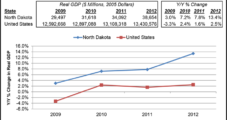Oil and gas patch output is typically measured in barrels or cubic feet, but gross domestic product (GDP) is another yardstick by which to chart growth, and that’s particularly true in North Dakota, home to the Bakken Shale, the U.S. Energy Information Administration (EIA) said Friday.
Measured
Articles from Measured
NTSB Confirms Thin Pipe Wall in West Virginia Rupture
A six-foot section of a 20-inch diameter Columbia Gas Transmission system that ruptured Dec. 11 in West Virginia had wall thickness measured as low as 0.078 inches, significantly thinner than the nominal wall thickness of 0.281 inches when the pipeline was installed in 1967, according to a preliminary report issued Wednesday by the National Transportation Safety Board (NTSB).
NTSB Confirms 70% Wall Thickness Loss in Columbia Rupture
A six-foot section of a 20-inch diameter Columbia Gas Transmission system that ruptured Dec. 11 in West Virginia had wall thickness measured as low as 0.078 inches, significantly thinner than the nominal wall thickness of 0.281 inches when the pipeline was installed in 1967, according to a preliminary report issued Wednesday by the National Transportation Safety Board (NTSB).
Unconventional Rig Count Continues to Show Gas-to-Oil Migration
With the natural gas price slump now being measured in terms of years instead of months, producers continue to pull rigs from dry gas unconventional plays to pursue oil targets, according to NGI’s Shale Daily Unconventional Rig Count.
Environmental Group: Go-Slow Approach Right for Oil Shale
The U.S. Bureau of Land Management (BLM) has the right idea with its measured approach to oil shale production in the western United States given the risks involved, according to a white paper by sustainability advocate Ceres.
Portland General: Oregon’s Energy Growth Returns
For the first time since the recession hit in 2008, energy growth has been measured in Oregon, according to senior executives at Portland General Electric (PGE), who reported slightly reduced year/year earnings during a second quarter conference call with financial analysts last week. As a result, PGE’s latest plans call for increased natural gas-fired power generation — both peaking and baseload.
Portland General Resumes Energy Growth in Oregon
For the first time since the recession hit, energy growth has been measured in Oregon, according to senior executives at Portland General Electric (PGE), who reported slightly reduced year/year earnings during a second quarter conference call with financial analysts. As a result, PGE’s latest plans call for increased natural gas-fired power generation — both peaking and baseload.
Internal Review by Times Critical of Shale Reporting Tactics
Arthur Brisbane, who acts as the “readers’ representative,” wrote an opinion piece in the Sunday Times following accusations by critics that the newspaper and reporter Ian Urbina had used “fear mongering” to criticize the industry, comparing it to a “Ponzi” scheme with a future like Enron Corp. or the dot-com bubble (see Shale Daily, June 28). Brisbane researched the methods used by the reporter and editors and followed up with his commentary.
Prices Fall on Waning Heating Load, Weaker Screen
A day after recording double-digit increases across the board, the cash market moved in the opposite direction Tuesday with declines measured in double digits at nearly all points. Heating load continued to recede in northern market areas with very little new air conditioning load surfacing to offset the demand loss, and Monday’s screen drop of 4.2 cents was followed by further softness at Nymex Tuesday.
Cash Price Downturn Measured in Double Digits
Moderating weather, continuing energy futures weakness and falling prices in Tuesday’s later deals led to across-the-board softening Wednesday. Declines were in double digits, with most in the teens, but they ranged as high as about 30 cents in the Rockies.





